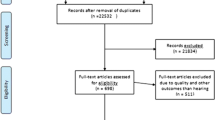Abstract
In experimental studies it was found that otitis media causes stiffness loss in the tympanic membrane, possible precursors to retraction pockets and cholesteatoma. Besides otitis media habitual sniffing behaviour is associated with the development of retractions. The present study aims to test the hypothesis that repeated sniffing manoeuvre may cause not only structural, epithelial tympanic membrane changes presumed to be possible precursors to retractions, but also tympanic membrane stiffness loss, another possible mediator for the development of retractions. An experimental model with a pressure chamber was used to mimic the pressure conditions for the tympanic membrane in habitual sniffers’ ears. The stiffness properties of twelve Mongolian gerbil tympanic membranes were measured with moiré interferometry after varying time up to 12 days with repeated pressure loading. Three days later, lower overall displacement were obtained in two ears; after 7–12 days the displacement readings were normal. This study with maximum of 12 days of pressure loading did not verify the hypothesis that habitual “sniffing” impairs the stiffness of the tympanic membrane.


Similar content being viewed by others
References
Hergils L, Magnusson B (1990) Human middle ear gas composition studied by mass spectrometry. Acta Otolaryngol 110(1–2):92–99. doi:10.3109/00016489009122520
Hergils L, Magnusson B (1987) Middle-ear pressure under basal conditions. Arch Otolaryngol Head Neck Surg 113(8):829–832
Tideholm B, Jönsson S, Carlborg B, Welinder R, Grenner J (1996) Continuous 24-hour measurement of middle ear pressure. Acta Otolaryngol 116(4):581–588. doi:10.3109/00016489609137893
Falk B (1981) Negative middle ear pressure induced by sniffing. A tympanometric study in persons with healthy ears. J Otolaryngol 10(4):299–305
Taylor DM, O`Toole KS, Ryan CM (2003) Experienced scuba divers in Australia and the United States suffer considerable injury and morbidity. Wilderness Environ Med 14(2):83–88
Klingman C, Praetorius M, Baumann I, Plinkert PK (2007) Otorhinolaryngologic disorders and diving accidents: an analysis of 306 divers. Eur Arch Otorhinolaryngol 264(10):1243–1251. doi:10.1007/s00405-007-0353-6
Phillips YY, Zajtchuk JT (1989) Blast injuries of the ear in military operations. Ann Otol Rhinol Laryngol Suppl 140:3–4
Mrena R, Pääkkönen R, Bäck L, Pirvola U, Ylikoski J (2004) Otologic consequences of blast exposure: a Finnish case study of a shopping mall bomb explosion. Acta Otolaryngol 124(8):946–952. doi:10.1080/00016480310017045
von Unge M, Decraemer WF, Dirckx JJ, Bagger-Sjöbäck D (1995) Shape and displacement patterns of the gerbil tympanic membrane in experimental otitis media with effusion. Hear Res 82:184–196. doi:10.1016/0378-5955(94)00017-K
Larsson C, Dirckx JJ, Bagger-Sjöbäck D, von Unge M (2005) Pars flaccida displacement pattern in otitis media with effusion in the gerbil. Otol Neurotol 26:337–343. doi:10.1097/01.mao.0000169770.31292.75
von Unge M, Decraemer WF, Dirckx JJJ, Bagger-Sjöbäck D (1999) Tympanic membrane displacement patterns in experimental cholesteatoma. Hear Res 128:1–15. doi:10.1016/S0378-5955(98)00183-X
Larsson C, Dirckx JJ, Decraemer WF, Bagger-Sjöbäck D, von Unge M (2003) Pars flaccida displacement pattern in purulent otitis media in the gerbil. Otol Neurotol 24:358–364. doi:10.1097/00129492-200305000-00002
Ramos CC, Rapoport PB (2005) Brito Neto RV clinical and tympanometric findings in repeated recreational scuba diving. Travel Med Infect Dis 3(1):19–25. doi:10.1016/j.tmaid.2004.06.002
Ivarsson A, Tjernström O, Uddman R (1980) The elastic properties of the tympanic membrane system in divers and non-divers. Acta Otolaryngol 89(1–2):33–36. doi:10.3109/00016488009127105
Magnusson B, Falk B (1983) Eustachian tube malfunction and middle ear disease in new perspective. J Otolaryngol 12(3):187–193
Falk B, Magnusson B (1984) Evacuation of the middle ear by sniffing: a cause of high negative pressure and development of middle ear disease. Otolaryngol Head Neck Surg 92(3):312–318
Magnusson K, Hellström S, Magnusson B (1995) Structural changes in the rat tympanic membrane following repeated pressure loads. Eur Arch Otorhinolaryngol 252(2):76–82. doi:10.1007/BF00168024
von Unge M, Decraemer WF, Bagger-Sjöbäck D, Dirckx JJ (1993) Displacement of the gerbil tympanic membrane under static pressure variations measured with a real-time differential moiré interferometer. Hear Res 70:229–242. doi:10.1016/0378-5955(93)90161-S
Bunne M, Falk B, Hellström S, Magnusson B (1999) The character and consequences of disturbing sound sensations in retraction type middle ear disease. Int J Pediatr Otorhinolaryngol 51(1):11–21. doi:10.1016/S0165-5876(99)00249-9
Dirckx JJJ, Decraemer WF (1992) Area change and volume displacement of the human tympanic membrane under static pressure. Hear Res 62:99–104. doi:10.1016/0378-5955(92)90206-3
Dirckx JJJ, Decraemer WF (1991) Human tympanic membrane deformation under static pressure. Hear Res 51:93–106. doi:10.1016/0378-5955(91)90009-X
Dirckx JJJ, Decraemer WF (2001) Effect of middle ear components on eardrum static deformation. Hear Res 157:124–137. doi:10.1016/S0378-5955(01)00290-8
Acknowledgments
The technical assistance of Mikael Eriksson, Karolinska University Hospital, is gratefully acknowledged. The study was supported by grants from Centrum för Klinisk Forskning, Landstinget Västmanland, Stiftelsen Tysta Skolan and Gösta Fraenkels Stiftelse för Medicinsk Forskning, Sweden. The study was approved by Stockholms Norra Djurförsöksetiska Nämnd (Dnr. N. 170/94).
Author information
Authors and Affiliations
Corresponding author
Rights and permissions
About this article
Cite this article
von Unge, M., Dircks, J.J. Functional effects of repeated pressure loads upon the tympanic membrane: mechanical stiffness measurements after simulated habitual sniffing. Eur Arch Otorhinolaryngol 266, 1219–1224 (2009). https://doi.org/10.1007/s00405-008-0906-3
Received:
Accepted:
Published:
Issue Date:
DOI: https://doi.org/10.1007/s00405-008-0906-3




